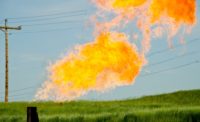The U.S. Environmental Protection Agency has finalized a rule that it says will prevent an estimated 58-million tons of methane emissions between 2024 and 2038—the equivalent of 1.5- billion metric tons of carbon dioxide—and provide more than $7 billion annually in climate and public health benefits in that same time frame.
EPA Administrator Michael Regan and U.S National Climate Advisor Ali Zaidi announced the final rule Dec. 2 at COP28, the international climate conference in Dubai, Nov. 30 through Dec. 12. The rule strengthens the proposal released in November 2021 and incorporates additional measures recommended in a supplemental proposal released last December.
The final rule, which for the first time covers petroleum infrastructure built before 2015, will phase out routine flaring of natural gas produced by new oil wells, a leading current cause of methane emissions in the U.S.; require monitoring for leaks from well sites and compressor stations; and establish standards that require reduction in emissions from high-emitting equipment, such as controllers, pumps and storage tanks.
Not only will the final rule reduce emissions, it also will prevent natural gas resources from being wasted, Biden administration officials note.
The rule would cut methane emissions from regulated sources by nearly 80% by 2038, compared with current practices, Regan said.
Zaidi said in a statement that the administration is making it a priority to reduce methane emissions, which are considered to be much more potent than carbon dioxide emissions, by using a variety of approaches.
These range from “mobilizing billions in investment to plug orphaned wells, patch leaky pipes and reclaim abandoned mines to setting strong standards that will cut pollution from the oil and gas sector,” he said. Under the rule, EPA also will certify third-parties to identify “super-emitters” responsible for a disproportionate amount of methane emissions.
Concessions to Industry
The oil and gas sector has said it has voluntarily taken steps to reduce methane emissions, and several industry groups and firms, including energy giant BP, said they supported the final rule after it was announced at COP28.
EPA says it made some concessions to the industry in the final rule. These include giving energy facility owners and operators more flexibility in the types of technologies they use to comply with the rule, as well as shifting the date that a facility would need to have been built for it to be considered a “new” rather than an “existing” methane source. That date is now Dec. 6, 2022, rather than Nov. 15, 2021.
Shifting the “applicability date” that emissions sources would have to be constructed to be subject to federal New Source Performance Standards—which is embedded in the rule— means fewer sources would be considered “new" under that requirement.
The rule also gives industry more time to prepare to meet the standards and allows some lower-emitting wells to continue flaring.
Environmental groups, which have long advocated for methane emissions cuts as crucial to address global warming, praised the rule. But they emphasized it needs to be effectively enforced.
While it is encouraging that some national oil companies have for the first time set methane reduction targets, most global energy producers already have them but monitoring and enforcement are insufficient, said Melanie Robinson, global climate program director at the World Resources Institute. “Strong measures to verify progress are crucial to holding oil and gas companies accountable,” she added.
EPA said it plans to use enforcement mechanisms outlined in the Inflation Reduction Act, which provided $1.5 billion in grants, rebates, contracts and loans to a newly established Methane Emissions Reduction Program. Beginning in 2025, EPA will impose a charge on oil and gas companies that exceed more than 25,000 metric tons of carbon dioxide equivalent gas in the previous year.
The charge will phase up over time to a fee of $1,500 for each excess ton of methane emissions. The fees will help pay for monitoring and cleaning up excess industry methane emissions.
Oil and Gas Decarbonization Charter
Also on Dec. 2, COP28 President Sultan Al Jaber, who is CEO of Abu Dhabi National Oil Co., announced the launch of an effort to speed up climate actions within the oil and gas sector. About 50 national oil companies and global energy firms, representing more than 40% of global oil production have signed the Oil and Gas Decarbonization Charter, committing to net-zero operations by 2050 and ending routine flaring by 2030.
Jaber's firm is one of the national oil company signatories, with others including Saudi Aramco, Petrobras in Brazil, Pakisan Petroleum and Equinor in Norway. Global energy giants signing include BP, Shell, TotalEnergies, ExxonMobil and Repsol.
“The launch of the [charter] is a great first step,” Al Jaber said in a statement. He said he knows its signatories “can and need to do more. We need the entire industry to keep 1.5C within reach and set even stronger ambitions for decarbonization.”
United Nations Secretary-General Antonio Guterres expressed skepticism about the sincerity of the effort. “There’s no room for greenwashing,” he said Dec. 3.
The UN Environment Program's International Methane Emissions Observatory, advocacy group Environmental Defense Fund and the International Energy Agency also are set assist in compliance monitoring by tracking methane emissions using satellite data, among other tools.





